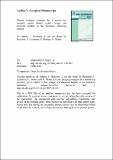Files in this item
Diverse foraging strategies by a marine top predator : sperm whales exploit pelagic and demersal habitats in the Kaikōura submarine canyon
Item metadata
| dc.contributor.author | Guerra, M. | |
| dc.contributor.author | Hickmott, L. | |
| dc.contributor.author | van der Hoop, J. | |
| dc.contributor.author | Rayment, W. | |
| dc.contributor.author | Leunissen, E. | |
| dc.contributor.author | Slooten, E. | |
| dc.contributor.author | Moore, M. | |
| dc.date.accessioned | 2018-08-31T08:35:25Z | |
| dc.date.available | 2018-08-31T08:35:25Z | |
| dc.date.issued | 2017-10 | |
| dc.identifier.citation | Guerra , M , Hickmott , L , van der Hoop , J , Rayment , W , Leunissen , E , Slooten , E & Moore , M 2017 , ' Diverse foraging strategies by a marine top predator : sperm whales exploit pelagic and demersal habitats in the Kaikōura submarine canyon ' , Deep Sea Research Part I: Oceanographic Research Papers , vol. 128 , pp. 98-108 . https://doi.org/10.1016/j.dsr.2017.08.012 | en |
| dc.identifier.issn | 0967-0637 | |
| dc.identifier.other | PURE: 251439165 | |
| dc.identifier.other | PURE UUID: a4a2d04d-3d53-4e78-8863-3152eb1e5432 | |
| dc.identifier.other | RIS: urn:A2755AD41D991B389806A81698D0E598 | |
| dc.identifier.other | Scopus: 85028743461 | |
| dc.identifier.other | WOS: 000414820600007 | |
| dc.identifier.uri | https://hdl.handle.net/10023/15915 | |
| dc.description | Support for this work was provided from contributions by Ray Dalio to the WHOI Access to the Sea Fund. | en |
| dc.description.abstract | The submarine canyon off Kaikōura (New Zealand) is an extremely productive deep-sea habitat, and an important foraging ground for male sperm whales (Physeter macrocephalus). We used high-resolution archival tags to study the diving behaviour of sperm whales, and used the echoes from their echolocation sounds to estimate their distance from the seafloor. Diving depths and distance above the seafloor were obtained for 28 dives from six individuals. Whales foraged at depths between 284 and 1433 m, targeting mesopelagic and demersal prey layers. The majority of foraging buzzes occurred within one of three vertical strata: within 50 m of the seafloor, mid-water at depths of 700-900 m, and mid-water at depths of 400-600 m. Sperm whales sampled during this study performed more demersal foraging than that reported in any previous studies – including at Kaikōura in further inshore waters. This suggests that the extreme benthic productivity of the Kaikōura Canyon is reflected in the trophic preferences of these massive top predators. We found some evidence for circadian patterns in the foraging behaviour of sperm whales, which might be related to vertical movements of their prey following the deep scattering layer. We explored the ecological implications of the whales’ foraging preferences on their habitat use, highlighting the need for further research on how submarine canyons facilitate top predator hotspots. | |
| dc.language.iso | eng | |
| dc.relation.ispartof | Deep Sea Research Part I: Oceanographic Research Papers | en |
| dc.rights | © 2017 Elsevier Ltd. This work has been made available online in accordance with the publisher’s policies. This is the author created, accepted version manuscript following peer review and may differ slightly from the final published version. The final published version of this work is available at https://doi.org/10.1016/j.dsr.2017.08.012 | en |
| dc.subject | Submarine canyon | en |
| dc.subject | Sperm whale | en |
| dc.subject | Foraging | en |
| dc.subject | Kaikoura | en |
| dc.subject | Echolocation | en |
| dc.subject | Demersal | en |
| dc.subject | QH301 Biology | en |
| dc.subject | NDAS | en |
| dc.subject | SDG 14 - Life Below Water | en |
| dc.subject.lcc | QH301 | en |
| dc.title | Diverse foraging strategies by a marine top predator : sperm whales exploit pelagic and demersal habitats in the Kaikōura submarine canyon | en |
| dc.type | Journal article | en |
| dc.description.version | Postprint | en |
| dc.contributor.institution | University of St Andrews. School of Biology | en |
| dc.contributor.institution | University of St Andrews. Sea Mammal Research Unit | en |
| dc.identifier.doi | https://doi.org/10.1016/j.dsr.2017.08.012 | |
| dc.description.status | Peer reviewed | en |
| dc.date.embargoedUntil | 2018-08-31 |
This item appears in the following Collection(s)
Items in the St Andrews Research Repository are protected by copyright, with all rights reserved, unless otherwise indicated.

